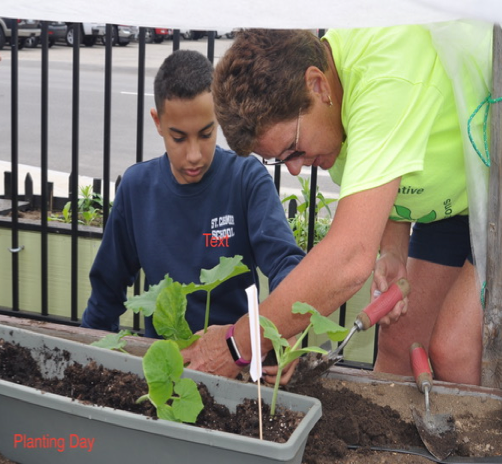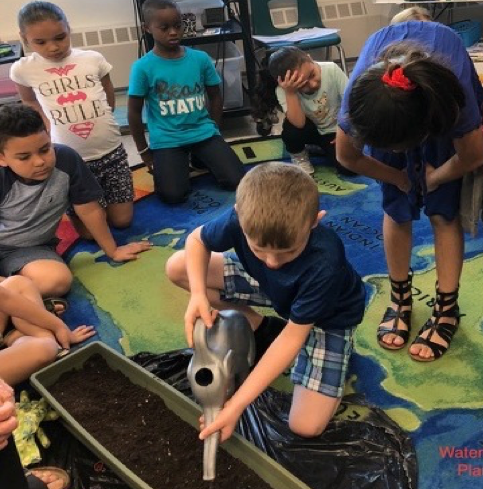From Seed to Supper: Pioneers Dig in to Help Kids — and Gardens — Grow
When you go to the grocery store or local farmers’ market and survey the vast, colorful array of fresh fruits and vegetables, do you ever stop to wonder where it comes from? How much work is involved in the process of nurturing tiny seeds to harvesting the produce that ends up on your dinner table? How does your food get from farm to table?
The New Vision Pioneers in New Hampshire think about the process often, because they have been volunteering with local schools for several years to teach children how to cultivate and grow vegetables and herbs — starting with seeds and eventually making supper.
Each spring for the past five years, these Pioneers, along with volunteers from the Greenhouse Collaborative and the New Horizons soup kitchen, band together to work with several schools in lower-income school districts around Manchester, New Hampshire.
Last year, the seed to supper project was brought to life by 275 students, eight teachers, and 26 volunteers, who spent over 520 hours digging in for a great cause.
Plant — And Grow
 It starts with the tiniest of seeds — zucchini, tomatoes, squash, basil and more. Along with teachers, the students and volunteers work together to establish small seed gardens in the classrooms. The Greenhouse Collaborative provides composted soil and then the students (mostly in third grade) plant the seeds and nurture them until it is time to transplant the seedlings at the greenhouse.
It starts with the tiniest of seeds — zucchini, tomatoes, squash, basil and more. Along with teachers, the students and volunteers work together to establish small seed gardens in the classrooms. The Greenhouse Collaborative provides composted soil and then the students (mostly in third grade) plant the seeds and nurture them until it is time to transplant the seedlings at the greenhouse.
In a few schools, hydroponic systems are being monitored by students. With hydroponics, plants are cultivated by placing the roots in a liquid nutrient solution (and water) rather than soil.
Once the seedlings are established enough be transplanted, the students and volunteers transport them to the greenhouse and plant them. The Pioneers work closely with the Greenhouse Collaborative to cultivate produce for use in the New Horizons soup kitchen and food pantry. The greenhouse, the only urban facility of it’s type in all of New Hampshire, provides approximately 2,500 pounds of produce annually to the soup kitchen, which is used in salads and meals.
Compost — And Renew
For many of the schools, the Greenhouse Collaborative provides the composted soil for planting. But, last year, an outdoor composting operation was also introduced at one of the schools. Students collected vegetable and fruit scraps from their daily lunches and deposited them in compost bins. This compost was then used in their seed to supper project in 2019! The Pioneers hope to keep adding compost bins, so eventually all the schools that participate in the project create their own compost.
Worm farms are also being cultivated at two schools — to the delight of the students who get to take care of them! The worms act as living compost and help reduce use of soil. Composting helps the students understand the cycle of renewable growth and recycling.
The students fully embrace the responsibility of nurturing the plants (and worms!) and maintaining the hydroponic systems. A teacher described one child who sometimes skipped school. She recruited him to make sure there was enough water for the hydroponic system every day. He was seldom absent again as he loved the responsibility of his job!
Harvest — And Serve
 Once the vegetables reach maturity, the students and volunteers convene at the greenhouse to harvest their haul. The students are thrilled to see how the tiny seeds they planted have grown! Then the vegetables and herbs are delivered to the New Horizons soup kitchen to be used to prepare meals for those who have a hard time finding healthy food. One of the favorite meals? Stuffed zucchini prepared by the chefs at the soup kitchen for the senior citizens to enjoy at Wednesday night suppers!
Once the vegetables reach maturity, the students and volunteers convene at the greenhouse to harvest their haul. The students are thrilled to see how the tiny seeds they planted have grown! Then the vegetables and herbs are delivered to the New Horizons soup kitchen to be used to prepare meals for those who have a hard time finding healthy food. One of the favorite meals? Stuffed zucchini prepared by the chefs at the soup kitchen for the senior citizens to enjoy at Wednesday night suppers!
Each year, the entire growing process is a lesson in patience for volunteers and students — from nurturing tiny seeds, to harvesting full-grown vegetables and, ultimately, to providing healthy meals for those in need. The plants and vegetables aren’t the only things that bloom during the process &mdash the volunteers and students cultivate strong friendships and gain life-long lessons in how to renew and reuse natural resources.